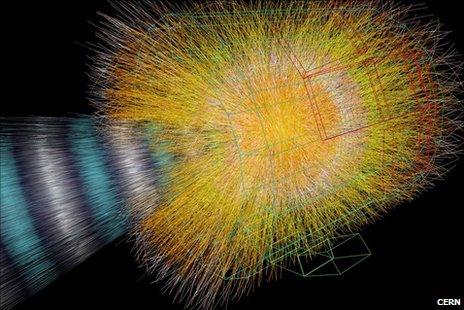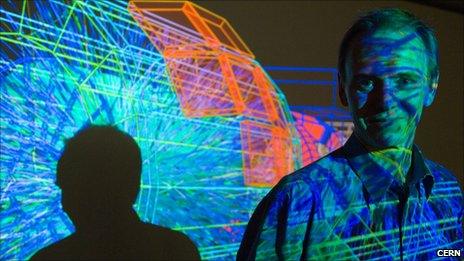LHC researchers 'set to create a mini-Big Bang'
- Published

The ALICE experiment has been designed for lead ions collisions (simulation)
Researchers at the Large Hadron Collider (LHC) are getting set to create the Big Bang on a miniature scale.
Since 2009, the world's highest-energy particle accelerator has been smashing together protons, in a bid to shed light on the fundamental nature of matter.
But now the huge machine will be colliding lead ions instead.
The experiments are planned for early November and will run for four weeks.
The LHC is housed in a 27km-long tunnel on the Franco-Swiss border and is managed by the European Organization for Nuclear Research (Cern).
The collider consists of four different experiments and one of them, ALICE, has been specifically designed to smash together lead ions.
The goal of these collisions is to investigate what the infant Universe looked like. Colliding protons at high energies was aimed at other aspects of physics, such as finding the elusive Higgs boson particle and signs of new physical laws, such as a framework called supersymmetry.
Cern's spokesman James Gillies told BBC News that besides ALICE, the ATLAS and Compact Muon Solenoid (CMS) experiments will also be temporarily colliding ions.
Big Bang
He said the tests could provide an insight into the conditions of the Universe some 13.7 billion years ago, just after the Big Bang.
They will look at the Universe fractions of a second after a tiny but very dense ball of energy exploded to create the cosmos as we know it today.
Scientists believe that it was back then that a special state of matter existed, different from the matter the Universe is formed of now.
"Matter exists in various states: you can take a material like water and if you deep freeze it, it'll be solid, and if you put it on a table, it'll turn into a liquid, and if you put it into a kettle, it'll turn into a gas," said Dr Gillies.
"It's all the same stuff, but those are different states of matter. And if you take materials into laboratories, you can pull the electrons off the atoms and you have another state of matter which is called plasma."
But at the very beginning of the Universe, there might have been yet another state of matter. Physicists have dubbed this "stuff" the quark-gluon plasma.
"And this is the state of matter you have if you're able to effectively melt the nuclear matter that makes up atoms today, releasing the things that are inside, which are quarks and gluons," Dr Gillies explained.
Quark and gluon soup
If the researchers at the LHC are able to recreate that state of matter and study it, they could get important clues about how it "evolved into the kind of matter that can make up you and me".
One of the scientists who will be taking a part in the experiment is David Evans from the University of Birmingham, UK.

Dr Evans is one of the scientists who will take part in the new experiment
"Although the tiny fireballs will only exist for a fleeting moment (less than a trillionth of a trillionth of a second) the temperatures will reach over ten trillion degrees, a million times hotter than the centre of the Sun," said Dr Evans.
"At the temperatures generated, even protons and neutrons, which make up the nuclei of the atoms, will melt, resulting in a hot, dense soup of quarks and gluons."
The researcher said that the temperatures and densities that the collider will aim to create will be the highest ever produced in an experiment.
- Published22 September 2010
- Published28 June 2010
- Published23 July 2010